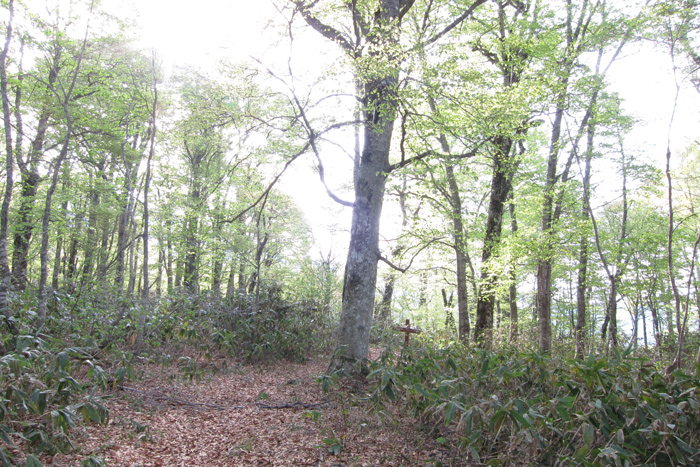
空から降ってくるのはなにも雨ばかりとはかぎらない。
春が来てしばらく経ち、あたりをとりまく暖かな空気にすっかり安心して、木々の新緑にも目が慣れた頃、街路樹や公園の木の下を歩くと、音もなく、小さななにかが頭上から落ちてくる。雨が降ってきたのかなと思うと、それは雨粒ではなく、ふわふわと細長いもので、目の前をちらちらと軽やかに飛んでいく。なんだろうと思ってよく見ようとしても、落ちるとすぐに地面へと紛れ込んでしまう。
この小さな雨は街だけでなく、山のなかでも降っている。山では、ぱらぱらと降る小雨というよりも、突然の驟雨(しゅうう)のようにさあっと降って止む、にわか雨である。
5月の半ば、山の春はまだ浅く、日陰には黒ずんだ雪が少し残っている。東京から3時間ほどの高原に出かけてくると、黄味の強い緑色をしたブナの若葉がきらきらと輝いている。時折遠くから鳥の声がかすかに聞こえてくる。あとは自分の足音しかしない。そんな静かな林のなかで、わずかにそよ風が吹くと、木々の梢が音もなく揺れ、茶色とも銀色ともいえない、花びらでもない小さなものが、目の前をひらひらひら、ひらひらひらと舞い散っていく。風が止むと周りの景色は再び静止して、鳥の声だけが聞こえる。そして雪どけの土の上には、ひらひらとしたかんなくずのような細かなものがいっぱい落ちている。
高原の宿で聞くと、この時期はブナの新芽を包んでいた殻が散るのだという。新芽の殻とは植物用語でいうと芽鱗(がりん)といって、厳しい冬を無事に越すために、木々が用意した防寒着である。暖かな春の訪れとともに、新芽は重いコートを脱ぐように固い芽鱗を破って、うすくてやわらかくて銀色のうぶ毛に包まれた、明るい黄緑色の葉を一斉に開く。そして脱ぎ捨てられた芽鱗は、折りからの春の強い風に乗って飛んでいく。そのようすを称して、山の人はブナ嵐と呼ぶそうだ。風の強い日に窓の外を見ていると、大きく揺れる木々から茶色い嵐のように芽鱗が飛んでいくのが見えるという。
ブナは雪深い寒い地方に生える木なので、残念ながら街のなかではほとんど見かけない。その代わり、同じ頃に街で降るのは、コナラやケヤキの細く長い雄花である。新芽と同時に開いた木々の花は、ひっそりとめだたないけれどもちゃんと咲いていて、他の花々と同じように、ある日静かに散っていく。ブナの新芽の茶色いコートとは違って、こちらは細い小枝にちっちゃな雄花が連なってついて、青いぶどうの実のようだ。今日も足もとに落ちていて、ときには髪の上や肩の先にそっと上陸している。
それは梅雨になる前、ごくかぎられたひととき、木々が降らす小さな緑の雨である。

It isn't necessarily all rain that falls from the sky.
Shortly after spring had come, when I had become comfortable with the warm air surrounding the environments, and had become accustomed to the fresh greenery of the trees, I was walking under the trees at the park and street when something small came falling onto my head silently. I thought it had started raining, but it wasn't a raindrop; it was a fluffy long and thin thing that fluttered away before my eyes. I tried to get a better look at it, wondering what it was, but as soon as it fell, it sank into the ground.
These small drops of rain fall not only in towns but also in mountains. In the mountains, it's a sudden shower that passes quickly rather than a light sprinkling.
In the plateaus three hours away from Tokyo, it's still barely spring in mid-May, there's still a little snow left and the trees are finally putting forth buds. The green young leaves of the beech tree, still a deep yellow color, are glistening in the light. Occasionally a bird's cry can be faintly heard from the distance. Other than that, there is only the sound of one's own footsteps. In the soft breeze, the treetops sway silently and the small things, neither brown nor silver nor flower petals, flutter to the ground before ones eyes. When the wind stops, the surrounding scenery stops once more and only the cry of the birds can be heard. Then on top of the slushy ground a great minutia of flittering shaving-like things have fallen.
At the lodgings in the plateau, they say that the husks covering the new buds of the beech trees fall during this season. In botany terminology, the husk of new buds are called bud scales. They are formed by trees as protection from the cold so that they can survive the harsh winters. With the coming of the warm spring, the new buds break free from the bud scales as if removing a heavy coat and the bright yellow and green leaves, covered in light, soft silver hairs, open up all at once. The cast off bud scales are then blown away in the spring winds. Those who reside in the mountains affectionately call it a “beech tree storm”. They say that when you look out the window on windy days, you can see the bud scales being blown away as if in a brown storm from the swaying trees.
Beech trees grow in cold, snowy areas, and unfortunately they are almost never seen in towns. Instead the long and thin staminate flowers of the Quercus serrata or Japanese zelkova are what falls in towns around the same time. The flowers of trees that bloom at the same time as the new buds don't stand out but are blooming, and, like other flowers, flitter to the ground quietly one day. Unlike the brown coat of the new beech tree buds, the small staminate flowers on the thin twigs of these trees are lined up like the fruits of green grapes. Today they've fallen at my feet, and sometimes softly land on my hair or on the tip of my shoulders.
It is a shower of greenery from trees for a very limited time before the rainy season.
Interview Article with Mrs. Akiko Wakana >
Day-to-Day Pilosophies


